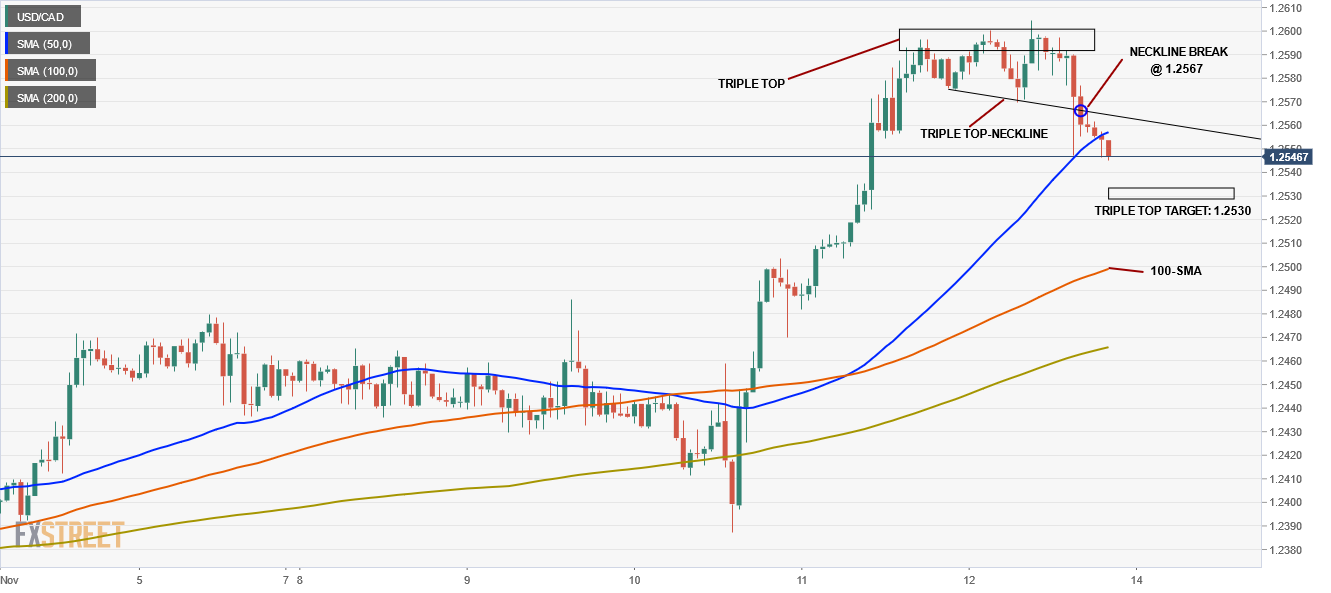- Analytics
- News and Tools
- Market News
- USD/CAD retreats from 1.2600, on weaker than expected US consumer sentiment
USD/CAD retreats from 1.2600, on weaker than expected US consumer sentiment
- USD/CAD slump for the first time in three days after posting losses of almost 1.70%.
- USD/CAD fell amid US dollar weakness across the board.
- USD/CAD: The 1-hour chart depicts a triple top chart pattern, with a target of 1.2530.
USD/CAD struggles to gain traction above 1.2600, is falling 0.31%, trading at 1.2549 during the New York session at the time of writing. The Canadian dollar has been under selling pressure, as witnessed by the price action in the last three days, down almost 1.70%. Nevertheless, on Friday, the Loonie has recovered some ground, mainly driven by USD profit-taking.
DXY falls as the weekend approaches but holds to the 95 figure
Meanwhile, the greenback is falling against most G8 currencies. The US Dollar Index measurement of the buck against six currencies slides 0.02%, sitting at 95.12. Contrarily, US T-bond yields rise, with the 10-year benchmark note rising two basis points, currently at 1.58%.
USD/CAD direction would lie in the hands of the Bank of Canada (BoC) and US dollar dynamics. However, on Wednesday, US inflation rose to a 30-year high above 6%, which spurred an upside move in US Treasuries and the US dollar.
On the macroeconomic front, the US economic docket featured the University of Michigan Consumer Sentiment Index for November edged lower to 66.8, lower than the 71.7 in October, marking the lowest reading since November 2011.
USD/CAD Price Forecast: Technical outlook

The 1-hour chart depicts a technical move that spurred the recovery of the Loonie. A triple-top chart pattern formed around the 1.2570-1.2600 range. The price broke below the neckline around 1.2567, which would act as resistance in case of an upward swing. Further, the USD/CAD price is under the 50-simple moving average (SMA), exerting additional selling pressure on the pair. The triple-top target is 1.2530, an area that confluences with the 50-day moving average (DMA).
A break below the triple’s top target would expose the 100-SMA around the 1.2500 figure.
© 2000-2024. All rights reserved.
This site is managed by Teletrade D.J. LLC 2351 LLC 2022 (Euro House, Richmond Hill Road, Kingstown, VC0100, St. Vincent and the Grenadines).
The information on this website is for informational purposes only and does not constitute any investment advice.
The company does not serve or provide services to customers who are residents of the US, Canada, Iran, The Democratic People's Republic of Korea, Yemen and FATF blacklisted countries.
Making transactions on financial markets with marginal financial instruments opens up wide possibilities and allows investors who are willing to take risks to earn high profits, carrying a potentially high risk of losses at the same time. Therefore you should responsibly approach the issue of choosing the appropriate investment strategy, taking the available resources into account, before starting trading.
Use of the information: full or partial use of materials from this website must always be referenced to TeleTrade as the source of information. Use of the materials on the Internet must be accompanied by a hyperlink to teletrade.org. Automatic import of materials and information from this website is prohibited.
Please contact our PR department if you have any questions or need assistance at pr@teletrade.global.















